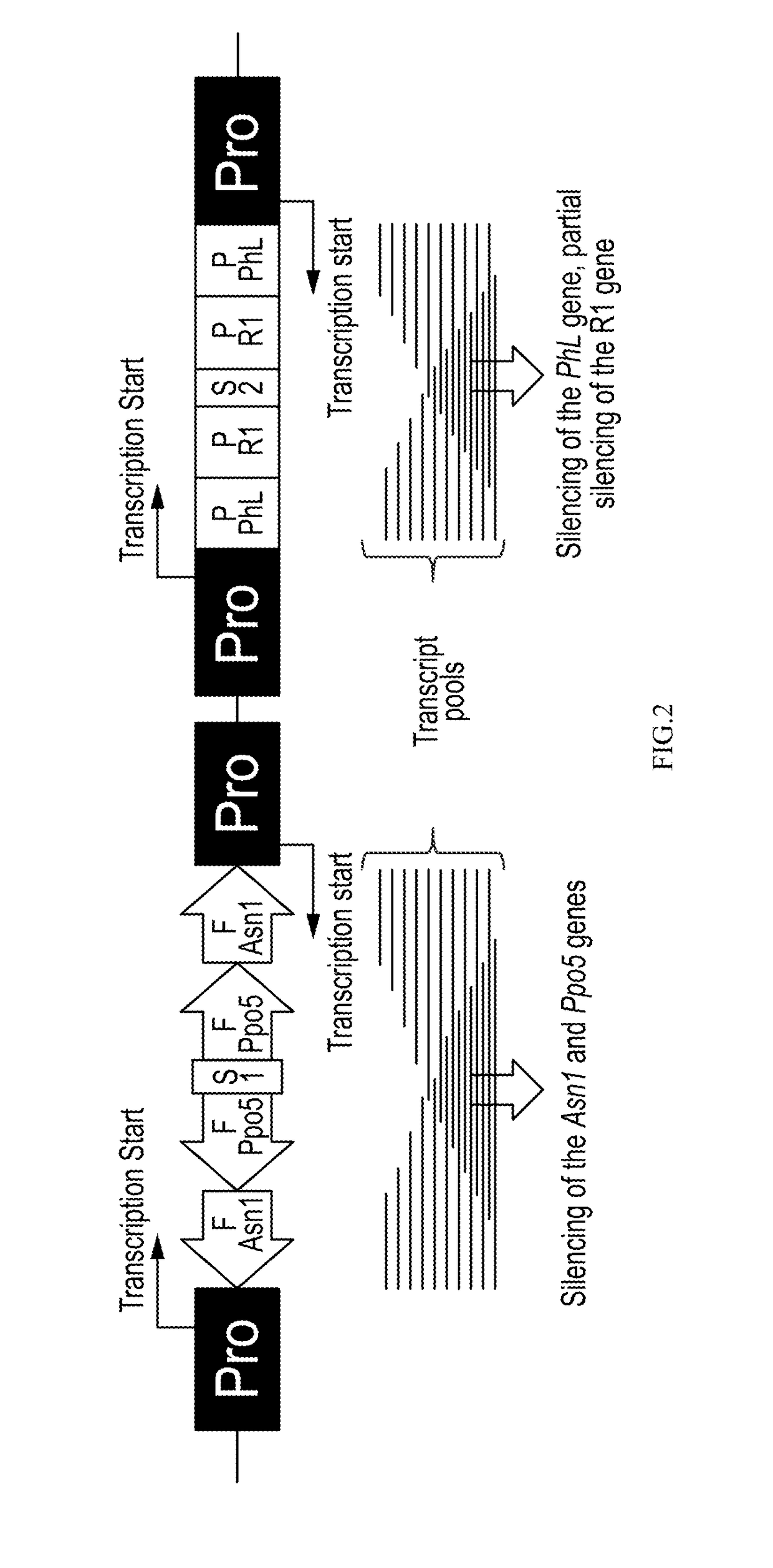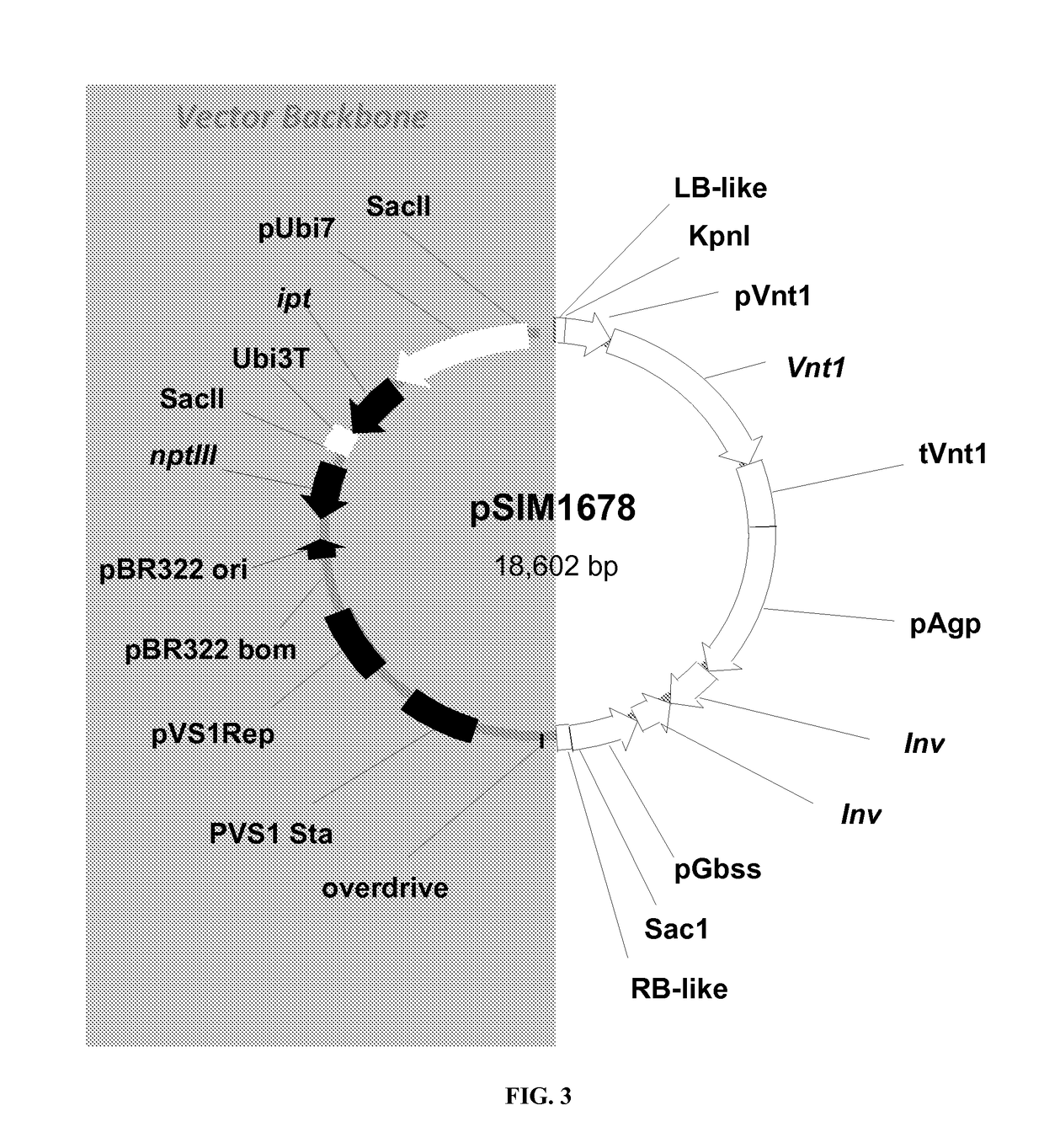Potato cultivar w8
- Summary
- Abstract
- Description
- Claims
- Application Information
AI Technical Summary
Benefits of technology
Problems solved by technology
Method used
Image
Examples
example 1
The pSIM1278 Transformation Vector
[0097]The transformation vector pSIM1278 used in the invention was derived from pSIM106, which was created by ligating a 0.4-kb potato plant DNA fragment (deposited as GenBank accession no. AY566555) with a 5.9-kb SacII-SphI fragment of pCAMBIA1301 (CAMBIA, Canberra, Australia), carrying bacterial origins of replication from plasmids pVS1 and pBR322, and the nptIII gene for bacterial resistance to kanamycin. An expression cassette comprising the Agrobacterium ipt gene preceded by the Ubi-3 promoter (Garbarino and Belknap, 1994) and followed by the Ubi-3 terminator was introduced as a 2.6-kb SacII fragment into the vector backbone (Rommens et al., 2004). Insertion of the native 10-kb DNA segment carrying two silencing cassettes into the DNA insert of pSIM106 yielded pSIM1278. This vector was used for all transformations. The pSIM1278 vector map is shown in FIG. 1. The vector backbone region is 9,512 bp, as it starts at position 10,149 bp and ends at ...
example 2
The pSIM1278 Plant DNA Insert and its Open Reading Frames (ORFs)
[0098]The pSIM1278 DNA insert region, including the flanking border sequences, used in the pSIM1278 is 10,148 bp long, from 1 bp to 10,148 bp. The pSIM1278 DNA insert consists of native DNA only and is stably integrated into the potato genome. The pSIM1278 DNA insert or a functional part thereof, is the only genetic material of vector pSIM1278 that is integrated in the potato plant varieties of the invention. The pSIM1278 DNA insert is described in FIG. 2 and Table 2 below. The LB and RB sequences (25 bp each) were synthetically designed to be similar to and function like T-DNA borders from Agrobacterium tumefaciens. The GenBank Accession AY566555 was revised to clarify the sources of DNA for the Border regions. ASN1 described as genetic elements 5 and 10 is referred to as StAst1 in Chawla et al., 2012.
TABLE 2AccessionPositionGenetic ElementOriginNumber(pSIM1278)Intended Function1. Left Border (LB) site1SyntheticAY56655...
example 3
The pSIM1678 Transformation Vector
[0100]The transformation vector pSIM1678 used in the invention was transformed using the same methods described for pSIM1278 in Example 1. The pSIM1678 vector map is shown in FIG. 3. The vector backbone region is 9,512 bp, as it starts at position 9,091 bp and ends at position 18,602 bp. The backbone DNA consists mainly of bacterial DNA and provides support maintenance of the DNA insert prior to plant transformation. The backbone portion is not transferred into the plant cells. The various elements of the backbone are described in Table 1. Although the numbering system shown in Table 1 is based on pSIM1278, the backbone sequences are identical for pSIM1678.
PUM
| Property | Measurement | Unit |
|---|---|---|
| Electrical resistance | aaaaa | aaaaa |
| Morphology | aaaaa | aaaaa |
Abstract
Description
Claims
Application Information
 Login to View More
Login to View More - R&D
- Intellectual Property
- Life Sciences
- Materials
- Tech Scout
- Unparalleled Data Quality
- Higher Quality Content
- 60% Fewer Hallucinations
Browse by: Latest US Patents, China's latest patents, Technical Efficacy Thesaurus, Application Domain, Technology Topic, Popular Technical Reports.
© 2025 PatSnap. All rights reserved.Legal|Privacy policy|Modern Slavery Act Transparency Statement|Sitemap|About US| Contact US: help@patsnap.com



